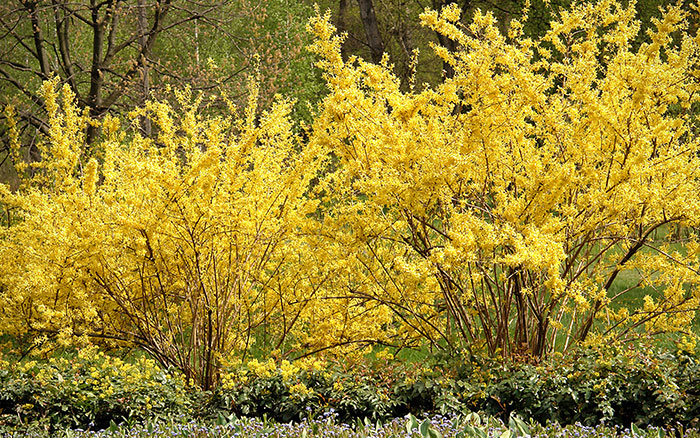Updated 15/02/25
Forsythias are hardy, robust shrubs. What’s more, they offer a delicate explosion of vibrant yellow flowers. This makes them a must-have flower in any Spring Garden. But how best to maintain them? Take a look at my tips for growing and pruning Forsythias.
Forsythia are considered hardy and easy-to-grow shrubs. They tolerate a wide range of soil types, and grow best in full sun and light shade. Because of their vibrancy and delicate flowers, Forsythia are a great choice for a flowering hedge. Adding a brilliant pop of colour to your garden. Plus, they’re easy to share! You can take cuttings of Forsythia to propagate another, and you can also cut the flowers off, to use as decoration.
Whilst they are straightforward shrubs, Forsythias do require some pruning. Because, without it, they tend to develop into tall, clumsy shrubs with congested growth and bare base stems.
However, when and how you go about pruning depends on what kind of Forsythia you’re looking after. Bear in mind, though, that pruning of any Forsythia should be complete before mid-July, if you want to give the plant enough time to put on new growth and develop flower buds.

Looking after forsythias
Food and water
If your Forsythia is new, it will need regular watering for the first few years. Particularly during dry spells in spring and summer.
Then, once their roots are established, they should be relatively drought tolerant and cope well without additional watering. Plus, Forsythia let you know they’re thirsty when their leaves begin to shrivel.
Generally, Forsythias need little to no regular feeding in most soil types. However, feeding is important if you want to encourage new growth after pruning in spring.
Also, Forsythias can produce odd-looking, flattened, elongated shoots that look like a bunch of squashed stems. These are called ‘fascinations’. And although they look a bit strange, they’re not actually harmful to the plant.

When should I prune my Forysthias?

Pruning young Forsythia plants
For young forsythia, you can basically let them get on with things themselves. If pruning is required, make sure it’s done in spring, immediately after flowering.
Make sure you:
- Simply remove any dead, damaged, or badly positioned shoots after flowering in late spring.
- And as an interesting (bit grim) aside, young forsythia can be fed twice a year with blood, fish, and bone to help establish a good root system!
Pruning established Forsythias
Established Forsythias should be pruned in mid-spring, immediately after flowering. And be aware that pruning any later means that the following spring’s flowering might be a little lacklustre.
Make sure you:
- Cut back flowered growth to vigorous upward and outward-facing shoots lower down.
- Remove up to 1/5 of the old stems from the base. This is important because it encourages new shoots to sprout.
- Then, thin out any crowded shoots in the centre of the bush, and remove any weak growth.


Pruning neglected forsythia
Give your misshapen or badly congested forsythia a new lease of life by hard pruning. This is best done between autumn and early spring. But bear in mind, the plant won’t flower the first post-prune spring.
The process is the same for Forsythia hedges, which should be pruned annually.
Make sure you:
- Cut out the thickest, oldest stems from the base.
- Remove the oldest wood, up to a third of the stems – each winter. And cut back any crossing branches.
- Then reduce the remaining wood by half after flowering.
Pruning wall-trained Forsythia
For wall-trained Forsythia, the aim is to cover a particular space, and train to horizontal wires or trellis attached to a wall or fence.
Make sure you:
- Reduce the length of flowered stems to one or two buds from the branched that form the main framework.
- If older framework branches haven’t formed well, then cut them out and select younger shoots as replacements.
- Then, tie these new stems into your desired position, to fill any gaps or extend the area covered.

So, there you have it! The ultimate guide to keeping your Forsythia fresh, happy, and healthy.
Frequently Asked Questions
1. What is forsythia?
This plant is a lovely decifuous shrub with bright yellow flowers which bloom in early spring. What’s striking about them is the flowers appear before the leaves. It is popularly used as hedging and for ornamental gardens.
2 – When does forsythia bloom?
Forsythia typically flowers quite early in the seeason, between late February and April.
3 – How do I plant forsythia?
It is best to plant forsythia in a position with full sun or partial shade. Ensure it has well-draining soil. Dig a hole twice the width of the rootball, but the same depth as the container. Finally, water thoroughly after planting.
4 – Can forsythia be grown in pots?
Yes, forsythia is quite suitable for growing in large containers. Make sure you water and prune regularly to care for it effectively.
5 – Does forsythia attract pollinators?
Forsythia is quite attractive to bees and other pollinators. They are particularly beneficial as they flower so early in the season.
6 – Why is my forsythia not blooming?
The most likely reason is either pruning too late in the season, not enough sunlight, improper soil conditions, or flower buds damaged by frost.

Leave A Comment